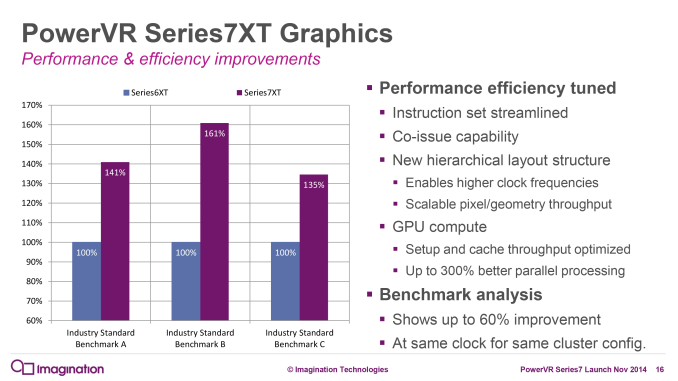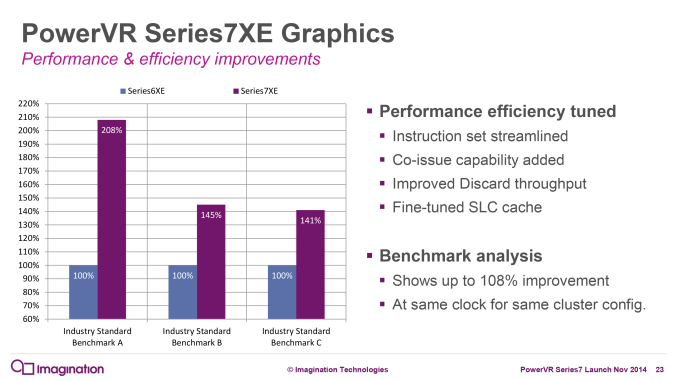Imagination Announces PowerVR Series7 GPUs - Series7XT & Series7XE
by Ryan Smith on November 10, 2014 8:50 AM EST- Posted in
- GPUs
- Mobile
- Imagination Technologies
- PowerVR
- PowerVR Series7
Performance Estimates
Wrapping things up, as Imagination is an IP licenser there isn’t any specific hardware to talk about or benchmark today, but Imagination has provided some performance estimates. As always these should be taken with a grain of salt, but until SoCs are released using the Series7 designs later next year, these are the best estimates we are going to see.
Ultimately the overall performance gains from 6XT to 7XT will depend on the application and the specific design goals of the SoC integrator, with Imagination’s internal data looking positive. At equal clockspeeds and cluster configurations, Imagination is showing performance gains of 30-60% for Series7XT. It should be noted that these numbers do not hold power consumption equal – higher utilization means transistors doing more work and burning energy more often – so real-world performance gains in power/heat limited scenarios would not be as great. But we are told to expect that at equal power levels performance should still be greatly improved over Series6XT, and even more over older Series6 devices.
Meanwhile from a performance perspective Imagination’s numbers paint 7XE as looking even better than 7XT on a relative gain basis. Once more holding core configurations and clockspeeds equal, performance is improved over 6XE by anywhere between 40% and 100%. No official explanation is provided for why 7XE benefits more than 7XT, but as 7XE has fewer USCs it also faces fewer bottlenecks from scaling, which can certainly be an advantage.
Closing Thoughts
All told, from top to bottom Series7 is designed to scale by a factor of 32; from ½ of a cluster up to 16 of them. With such a large range of configurations, Imagination is anticipating being able to cover the entire market with Series7, from wearable devices up to notebooks and even server compute clusters.
Meanwhile Imagination estimates that we should start seeing Series7 appear in retail roughly a year from now. This would be consistent with Series6XT/6XE, which were formally introduced at CES 2014 and hit the consumer market late in Q3 in devices such as the iPhone 6. We should see Series7 devices in roughly the same timeframe and consequently at this point it’s not unreasonable to expect Series7 to appear in Apple’s next SoC, judging from their history with Series6 and Series6XT.
With that said, it will be interesting to see how the SoC GPU market evolves over the next year leading up to Series7. Though very successful in supplying GPU IP to Apple, Imagination has been locked out of a number of potential Android devices due to Qualcomm’s strong position in that market and their own vertical integration. The launch of Android 5.0 “Lollipop” and its 64bit support serve as a potential catalyst for change in the Android hardware ecosystem, and while this is a battle that will initially be fought by Series6XT (as Cortex-A57 and A53 are already available), the transition time and the lead-in time required for SoC development means that Series7 will still play a big part in that.
Ultimately Series7 will be going up against stiff competition from a variety of competitors, so design wins will be hard-fought. In the GPU licensing space Imagination’s principle competition will be ARM and the recently-announced Mali 800 series (which will be available at roughly the same time). Meanwhile integrated SoC designers like Qualcomm and NVIDIA will also have competitive products such as the Adreno 400 series and Maxwell based Erista SoC respectively. So for 2015 as has been the case through 2013 and 2014, the SoC GPU space continues to be a busy and crowded market for Imagination, PowerVR Series7, and its competitors.













49 Comments
View All Comments
Badelhas - Monday, November 10, 2014 - link
Second!Nenad - Monday, November 10, 2014 - link
Seeing "these should be taken with a grain of salt" comment, I wonder if anyone ever did comparison of past announcements and how accurate they were? Was Imagination announcement for 6XT close to reality? How about similar pre-release figures given by NVidia, Intel etc... ?It would be interesting article on its own ;p
chizow - Monday, November 10, 2014 - link
I would say given the recent benchmark performances of both the Nexus 9 and iPad 2, both Nvidia and Imagination/Apple delivered on their claimed performance increases from this time last year and CES in the form of A8X and Tegra K1 (Denver). There's really only 2 players right now in the tablet ARM-based SoC market if you are looking at pure performance, Apple with PowerVR and Nvidia, everyone else is ~1.5 generations behind.kron123456789 - Monday, November 10, 2014 - link
That's why i wanna see what beast Nvidia will announce at CES 2015.LostAlone - Tuesday, November 11, 2014 - link
It's kinda silly to say only Tegra and Apple exist on the SoC market at the moment - The fact that those two happen to have just had their latest designs put to market in high profile tablet devices. There hasn't been a high end ARM tablet put to market in recent months that wasn't Tegra or an iDevice. So sure, they are technically winning that extremely specific race, but in the wider mobile sector (which uses the exact same SoCs most of the time) no-one has a clear lead.The most recent Snapdragon flagship won't be around for a while yet and the Exynos 5233 was only in some Note 4s and is yet to be in a mass market device, there's no suggestion that either of those two won't be competitive with the Apple and Nvidia going forward.
Obviously more recent chips tend to be better, so the ones we've seen most recently are very likely the most powerful of what there is at this exact second. But they certainly don't blow anything out of the water. Apple and Nvidia are doing good at this exact moment. Their chips compare well in benchmarks to what else is on the market. But those benchmarks are certainly not much ahead of what was on the market when they were released, and there's absolutely nothing to suggest that they are now somehow ahead of Qualcomms next generation, and the Exynos 5 series is certainly on par with them.
When the Tegra 4 came to market it was impressively ahead of the curve in graphics especially. But sadly no-one bought into all that much back then, and everyone else has continued pushing on with their own designs and closed that gap to the point where it's an even race. There is no generation gap what so ever.
And the thing is that none of this is even relevant anymore anyway. Mobile devices don't need better graphics. We don't make use of what we have already. Even if you do happen to be 15 and (somehow) have a flagship phone I severely doubt even someone with your buckets of free time and large periods waiting for buses and/or being driven around actually appreciate the (slight) difference between this years and last years flagships in terms of GPU power alone. Beyond that the amount of CPU horsepower in modern devices is laughably overblown now to the point where outside benchmarking you genuinely have to try very very hard to tap even a fraction of what the processor can do. At this point in the evolution of the mobile space the specs just don't make enough of a difference to wow people now. Last years flagships are still fine devices. The year befores are too. And the year befores. They might not all have the latest software, but they still do what they originally did just as well as ever they did it.
Just stop buying into the hype.
jospoortvliet - Tuesday, November 11, 2014 - link
You're pretty much right, but neglect to mention two things: improvements in features (like always-on voice detection, higher resolutions, better camera's etc; and then there are improvements like battery life, which, as owner of the One (m7) can appreciate: I don't care for the features or performance of the One (m8) but I would gladly spend a few hundred bucks for its battery life. And the move from a Snapdragon 600 to 80x is big in that regard...kron123456789 - Tuesday, November 11, 2014 - link
When first Tegra 4 came out, there already was Snapdragon 800(devices with those SoCs came out in summer 2013). When first device with Tegra K1 came out(Xiaomi MiPad), there wasn't anything, that could compete with it. When second device came out(Shield Tablet), there still wasn't anything. And when third K1 device came out(Nexus 9, with dual-core Denver CPU) there was ONLY iPad Air 2.K1 and A8x are the most powerful ARM SoCs right now, and that will be changed only in 2015. Exynos 7 Octa and Snapdragon 805 cant compete with K1 or A8X. But, there is one major problem with K1 and A8X - these are SoCs for tablets, not for smartphones.
So, yeah, in performace side Nvidia and Apple are 1.5 generations ahead.
chizow - Wednesday, November 12, 2014 - link
Exactly, and Nvidia still has 2 major trump cards to play with Erista which will have both 20nm and Maxwell GPU arch, so they'll extend their lead again as early as Q2.The problem Nvidia (and Apple) is their performance advantages right now are going to a blackhole, there's nothing that really takes advantage of this lead and therefore, they can't use this as an advantage to establish clear market dominance (at least for Nvidia on the Android side). Their challenge will be to grow the gaming ecosystem to take advantage of this benefit, but in the meantime, they will continue to iterate and dominate the competition.
chizow - Wednesday, November 12, 2014 - link
Who's buying into the hype when there's no need to? The latest two products on the market show Nvidia and Apple are head and shoulders above the competition and there is nothing on Qualcomm's roadmap that will challenge this until maybe next year, by which time Nvidia for sure will have punted the ball out of their range again with Erista (Maxwell and 20nm). Apple won't have as many levels to pull to improve A9, unless they also go with Maxwell GPU IP.http://anandtech.com/show/8670/google-nexus-9-prel...
lilmoe - Monday, November 10, 2014 - link
In response to the last paragraph, I thought the only competitor for Imagination's GPU was Mali (since both are the only GPUs that can be licensed to integrators)... Kepler/Maxwell and Adreno aren't in the "business space".